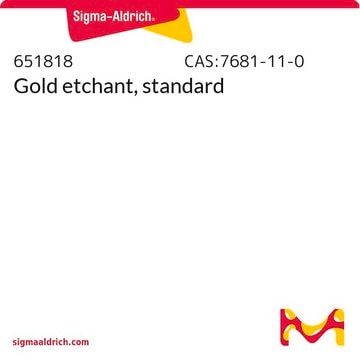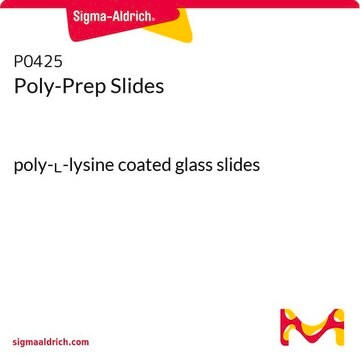643246
Gold coated glass slide
99.999% (Au), layer thickness 1000 Å
About This Item
Produits recommandés
Pureté
99.9% (Ti)
99.999% (Au)
L × l × épaisseur
3 in. × 1 in. × 0.7 mm
Épaisseur de la couche
1000 Å
Transmittance
380-700, >91% (for the glass microscope slide alone)
Indice de réfraction
n20/400 1.52 (lit.)
Fixation de matrice
Titanium, as adhesion layer used to bind the gold to the aluminosilicate glass cover slip
Chaîne SMILES
[Au]
InChI
1S/Au
Clé InChI
PCHJSUWPFVWCPO-UHFFFAOYSA-N
Vous recherchez des produits similaires ? Visite Guide de comparaison des produits
Catégories apparentées
Application
- Simple surface modification of poly(dimethylsiloxane) for DNA hybridization.: Highlights the application of gold-coated glass slides in creating effective biosensors for DNA hybridization, supporting innovations in genomics and pharmaceutical research (Zhou et al., 2010).
- Multimodal spectroscopy combining time-of-flight-secondary ion mass spectrometry, synchrotron-FT-IR, and synchrotron-UV microspectroscopies on the same tissue section.: Utilizes gold-coated glass slides to integrate multiple spectroscopic techniques, enhancing the analysis of complex biological samples, pivotal for cutting-edge research in biochemistry and material sciences (Petit et al., 2010).
Caractéristiques et avantages
Autres remarques
Code de la classe de stockage
11 - Combustible Solids
Classe de danger pour l'eau (WGK)
nwg
Point d'éclair (°F)
Not applicable
Point d'éclair (°C)
Not applicable
Certificats d'analyse (COA)
Recherchez un Certificats d'analyse (COA) en saisissant le numéro de lot du produit. Les numéros de lot figurent sur l'étiquette du produit après les mots "Lot" ou "Batch".
Déjà en possession de ce produit ?
Retrouvez la documentation relative aux produits que vous avez récemment achetés dans la Bibliothèque de documents.
Les clients ont également consulté
Articles
Hybrid organic-inorganic sol-gel materials containing silica were first called “ORMOSILs” in 1984.
Protocoles
SAMs are versatile surface coatings for chemical resistance, bio-compatibility, sensitization, and molecular recognition for sensors and nano fabrication.
Notre équipe de scientifiques dispose d'une expérience dans tous les secteurs de la recherche, notamment en sciences de la vie, science des matériaux, synthèse chimique, chromatographie, analyse et dans de nombreux autres domaines..
Contacter notre Service technique







